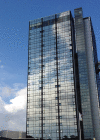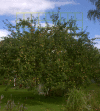A vision physiological estimation of ultraviolet window marking visibility to birds
- PMID: 25320684
- PMCID: PMC4194461
- DOI: 10.7717/peerj.621
A vision physiological estimation of ultraviolet window marking visibility to birds
Abstract
Billions of birds are estimated to be killed in window collisions every year, worldwide. A popular solution to this problem may lie in marking the glass with ultraviolet reflective or absorbing patterns, which the birds, but not humans, would see. Elegant as this remedy may seem at first glance, few of its proponents have taken into consideration how stark the contrasts between ultraviolet and human visible light reflections or transmissions must be to be visible to a bird under natural conditions. Complicating matters is that diurnal birds differ strongly in how their photoreceptors absorb ultraviolet and to a lesser degree blue light. We have used a physiological model of avian colour vision to estimate the chromatic contrasts of ultraviolet markings against a natural scene reflected and transmitted by ordinary window glass. Ultraviolets markings may be clearly visible under a range of lighting conditions, but only to birds with a UVS type of ultraviolet vision, such as many passerines. To bird species with the common VS type of vision, ultraviolet markings should only be visible if they produce almost perfect ultraviolet contrasts and are viewed against a scene with low chromatic variation but high ultraviolet content.
Keywords: Avian vision; Colour vision; Spectrophotometry; Ultraviolet light; Visual physiology; Window collision.
Figures











References
-
- Banks RC. Reflective plate glass—a hazard to migrating birds. BioScience. 1976;26:414.
-
- Hart NS. Vision in the peafowl (Aves: Pavo cristatus) Journal of Experimental Biology. 2002;205:3925–3935. - PubMed
LinkOut - more resources
Full Text Sources
Other Literature Sources

